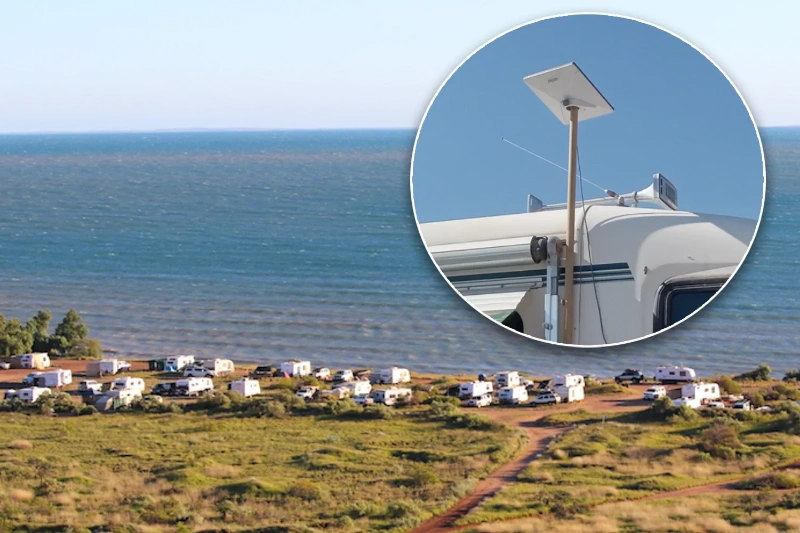$600 Starlink Mistake Sparks Warning for Aussie Travellers

With an increasing number of Australians living and working on the road, it is easy to make a simple error when moving between sites. One Australian traveler learned that lesson the hard way.
Like many others, he relies on Starlink for high-speed internet connectivity while camping in isolated locations around the country. The service provides blanket coverage through low-Earth orbit satellites that beam down to a customer's tiny receiving dish. As a result, folks with caravans and motorhomes frequently tie the dish to their vehicle or mount it to a pole on the van to raise it over any troublesome trees that might obscure the signal.
It sounds obvious, but the only catch is you have to remember to stow it away before proceeding to the next spot.
"A bit of a long shot, but if anybody is at Cleaverville Campground, WA, and has found a Starlink mini, can they let us know, and if it's salvageable," the traveller wrote last week after accidentally driving away with the dish still sticking out of their van.
Seeking assistance, he posted in a prominent caravanners' Facebook group, asking whether anyone remaining in the region could locate it. While one fellow traveler retraced his steps out of the WA campground, they were unable to find the dish, which costs $600 in Australia.
The camper, who asked to remain anonymous, told Yahoo that he had "no luck" finding it down and has contacted Starlink for assistance. He had been driving for a while with it hooked to the van before discovering, he explained.
With portable Starlink dishes becoming more common in campgrounds across the country, and the smaller 'Mini' version debuting in Australia last year, many simply responded to his call for assistance with the tricks they use to ensure they remember to collect their dish, such as leaving a sign on the steering wheel until it's packed away.
Dan and Amanda, an Australian couple, were among the first to use Starlink before the service was made available throughout the country.
"We strongly believe in not mounting it and just using it on its stand in the best position," Amanda told Yahoo News this week.
The couple spent more than two years traveling around Australia in their caravan, running an online business while on the road, and are currently traveling through Europe, where they continue to rely on the Starlink service for all of their connectivity needs.
"We did in Australia occasionally put it on the top of a mast to elevate it, which was mounted to the rear bar of our caravan, but that is a big pole, so hard to forget," joked the woman.
We keep it on our cab parcel shelf and periodically put it up through the roof hatch onto the roof.
Amanda stated that they have heard about incidents with Starlink dishes when traveling and nearly suffered a similar fate recently.
"We have heard of others driving over them on the ground when moving vehicles around in caravan parks or free camps," she told me.
"We forgot our dishy ('dishy' is the real name the company provides them) once when we were in Norway last year. We put it on the roof, but it was snowing, so all the hatches and windows were closed. We drove approximately 20 yards away from our parking location before immediately remembering it, thankfully. We came to a halt and grabbed it, [and from then on, we made it a habit to have Dan double-check every step."
She recommends that users leave the power cord in a highly visible location so that it is not overlooked while packing up, and that one camper be designated as the devoted person to remember the dish when it is time to pack up.
Starlink, owned by Elon Musk's SpaceX, is a private company that does not disclose detailed business statistics. However, it has previously stated that it has approximately 200,000 customers, the vast majority of whom would have the dish attached to their home for residential service, rather than the portable, roaming plan.
A Facebook group called Starlink Users Australia already has nearly 140,000 members, and YouTube is full of caravan and camping gurus offering advice on everything from how to attach it to the finest power supplies to support it.
It has grown more important for folks in regional Australia because it exceeds the NBN service in terms of speed and performance, as well as for nomadic Australians who have few options for a dependable internet connection.
However, this is about to change, as Amazon plans to launch its first satellites this year for a competitor service. Another launch this week would bring Amazon's 'Project Kuiper' to 78 satellites in orbit (Starlink reportedly has 8,000 satellites in its network). While Australia is claimed to be a priority market when the service is launched, it is unclear when it will become a realistic option for Australian clients.